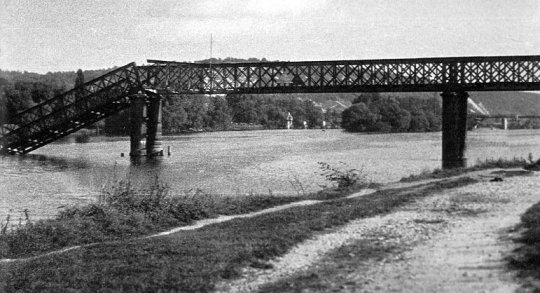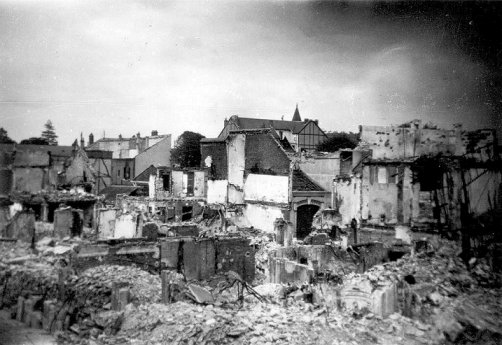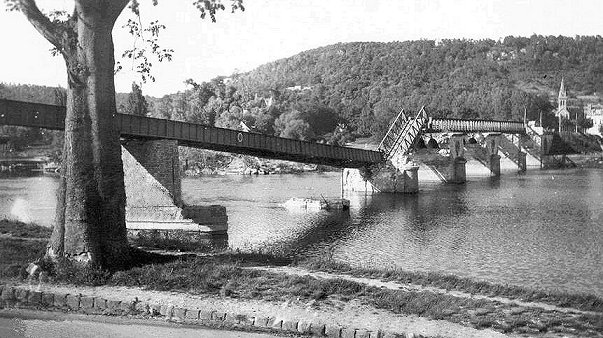1st Battalion Worcestershire Regiment - North West Europe 1944
VERNON - The River Seine Crossing (25th to 28th August 1944) - Part 1
Setting the Scene
The Liberation of Vernon in August 1944 was preceded by intense Allied bombing during the months April to August 1944. During this period Vernon suffered 34 air attacks, which destroyed or damaged 239 houses. On the morning of the 7th May 1944, the railway bridge that crossed the River Seine at Vernon was destroyed by seven American P-47 Thunderbolt fighter aircraft in a dive bombing run. It was the first time that this method was used in Normandy, and proved to be very effective. Only 7 tons of bombs were used. Several weeks later, on the evening of 26th May 1944, 73 American B-26 Marauder bombers dropped some 146 tons of bombs over Vernon. Forced to fly at high altitude, they lacked precision and as a result the Stone road bridge linking Vernon with Vernonnet was hit only once, making it was still passable for pedestrians. The town and people of Vernon suffered badly in this raid, some 45 people were killed and many more were wounded. The bombing totally destroyed 52 houses and damaged many more. |
Damaged Iron Rail Bridge at Vernon |
Bomb damaged houses in Vernon |
The goal of the Allied bombing was to cut the retreat of the occupying German forces by destroying the bridges over the River Seine. On the 8th June 1944, two days after the D-Day, 23 American B-26 bombers tried to finish off the job of destroying the road bridge at Vernon. Although they dropped 46 tons of bombs the target was not reached. However, 17 civilians were killed, and a further 20 suffered wounds. During 1944, the Resistance fighters of Vernon united themselves and on the 10th April 1944 they all joined the FFI (French Forces of the Interior) under the leadership of Georges André. With only a few weapons at their disposal their initial actions were limited. During their first action on the 18th August, they tried to blow up the remaining sections of the road bridge with plastic explosive. But due to the small amount of explosive they could lay their hands on (only about 7 kilos) it was not enough to cause any further damage to the bridge concrete piles. |
However, this action had a psychological effect and street fights erupted between Resistance fighters and German soldiers. On the 19th August, about forty French fighters struggled against three German tanks and two trucks around the city hall. Eventually, German troops retreated to Vernonnet and occupied the right bank of the river. Vernon had been liberated by its own forces, who continued to hold the town alone for a further week, until the British troops of the 43rd (Wessex) Division would arrive. On the 22nd August, the Resistance fighters dismissed the town council that obeyed the orders from Vichy and set up a new one. For the first time in over four years the French flag flew again from public buildings in the town. |
View of damaged road bridge at Vernon (May 1944) |
While the British and Canadian Corps were advancing to the Seine, preparations were completed for bridging the river. Between Rouen and Paris the river is about 250 yards wide and all the bridges had been broken by earlier air attacks. Though bridgeheads should be gained fairly easily, the building of new crossings to maintain a large force will take some time.
In XXX Corps the 43rd Division which was given the task of crossing at Vernon; for this it was organised in three groups. The first, with the troops and equipment for bridging the Eure river and assaulting the Seine, contained 1,500 vehicles; most of the artillery, and material for one bridge, were in the second group with 1,900 vehicles; the remainder of the division and about 1,000 vehicles formed the third. The leading group, which included the 1st Battalion Worcestershire Regiment, harboured in the forest of Breteuil for the night of the 24th August and sent forward its reconnaissances, together with some engineers to repair the bridge over the Eure at Pacy.
Two four-hour timings through the American XIX Corps area (along only one route) were now given to the 43rd Division for the 25th August. This allowed the first group to assemble at Vernon by 16.00 hours that day. This time slot proved insufficient for the other two groups who had to continue filtering through during the night.



